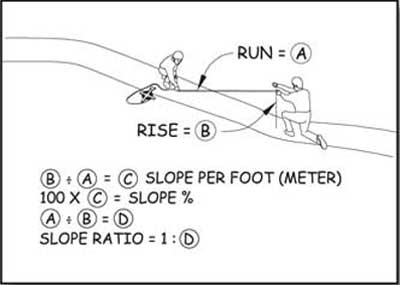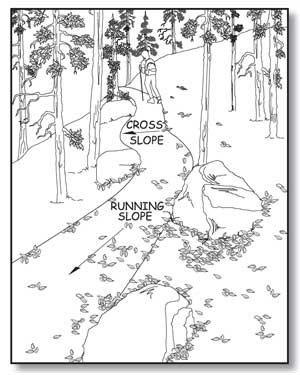Trail Slopes
Trail slopes must meet the requirements that follow. Steeper terrain makes it difficult to achieve flat grades everywhere. Many people are able to handle steeper slopes for short distances. Short sections of steeper trail are allowed so that trails can be constructed in varying terrain. The first general exception allows achieving trail slopes to the extent practicable if a condition for an exception prohibits full compliance with slope requirements
Running slope is the lengthwise slope of a trail, parallel to the direction of travel. In this guidebook, the terms running slope and grade often are used interchangeably. Trails or trail segments of any length may be constructed with a running slope ratio of up to 1:20 (a 5-percent grade). To accommodate steep terrain, trails may be designed with shorter segments that have a running slope (grade) and length as shown in table 5.
Table 5—Trail running slope and segment length.
| Running Slope of Trail Segments | Maximum Length of Segment Between Resting Intervals | |
|---|---|---|
| Steeper than | But no Steeper than | |
| 1:20 (5 percent) ) | 1:12 (8.33 percent) | 200 feet (61 meters |
| 1:12 (8.33 percent) | 1:10 (10 percent) | 30 feet (9 meters) |
| 1:10 (10 percent) | 1:8 (12 percent) | 10 feet (3.05 meters) |
Provide a resting interval between each of these steeper slope segments. To ensure that the trail is not designed as a series of steep segments, do not exceed a grade of 1:12 (8.33 percent) for more than 30 percent of the total length of the trail. The running slope (grade) must never exceed 1:8 (12 percent).
Construction Tip
Slope and grade terminology.
Slopes are often described as a ratio of vertical distance to horizontal distance, or rise to run (figure 130). For instance, a slope ratio of 1:20 means that for every foot of vertical rise, there are 20 feet of horizontal distance (or for every meter of vertical rise, there are 20 meters of horizontal distance).

Figure 130—Determining the slope ratio.
Cross slopes—the side-to-side slope of a trail tread (figure 131)—provide drainage to keep water from ponding and damaging the trail, especially on unpaved surfaces. Cross slopes that are too steep can be difficult to traverse, but trails with too little cross slope tend to become streams. Water running down or ponding on trails destroys them. Cross slopes are an important part of trail design and construction.

Figure 131—The running slope is measured along a trail's length; the cross slope is measured across its width.
Ensure that cross slopes do not exceed 1:20 (5 percent). If the trail surface is paved or built with boards, however, do not allow the cross slope to be steeper than 1:48 (2 percent).

User Comments/Questions
Add Comment/Question